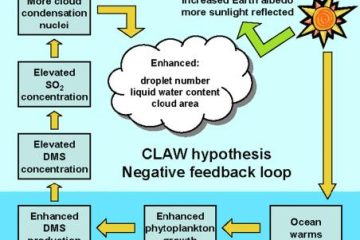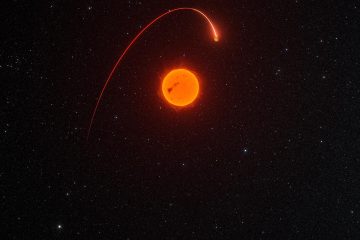In a world teeming with intricate ecosystems and interconnected life forms, the Gaia Hypothesis stands as a captivating lens through which we perceive the Earth. This hypothesis, postulated by James Lovelock in the 1970s, proposes that our planet functions as a self-regulating organism, delicately balancing various environmental factors to maintain conditions suitable for life. Let’s delve into the profound notes of the Gaia Hypothesis, exploring the harmonious dance between the Earth and its inhabitants that continues to inspire awe and curiosity in the realm of ecological science.
Table of Contents
- Exploring the Gaia Hypothesis: A Comprehensive Overview
- Key Points to Understand in the Gaia Hypothesis
- Practical Applications of the Gaia Hypothesis in Environmental Science
- Implementing Gaia Hypothesis Concepts for Sustainable Living
- Q&A
- The Conclusion
Exploring the Gaia Hypothesis: A Comprehensive Overview
In the realm of ecological studies, the Gaia Hypothesis stands as a fascinating theory that proposes the Earth functions as a self-regulating entity, akin to a living organism. This revolutionary concept, introduced by James Lovelock in the 1970s, suggests that the planet and all its living components form a complex, interconnected system that strives to maintain environmental balance.
One of the key tenets of the Gaia Hypothesis is the idea that the Earth actively regulates its atmospheric and surface conditions to support and sustain life. Through intricate feedback mechanisms involving the atmosphere, oceans, and living organisms, Gaia, the hypothetical self-regulating Earth system, works to create a conducive environment for the continuation of diverse life forms on the planet.

Key Points to Understand in the Gaia Hypothesis
In exploring the intriguing Gaia Hypothesis, it’s essential to grasp a few key concepts that underpin this fascinating ecological theory. One fundamental aspect to understand is the interconnectedness of all living organisms with their environment. In Gaia’s view, the Earth functions as a self-regulating system, almost like a living organism itself, where every component plays a vital role in maintaining the planet’s balance and harmony.
Moreover, the Gaia Hypothesis emphasizes the idea that the Earth and its biosphere operate as a single, unified entity. This holistic perspective challenges conventional beliefs about the Earth merely being a collection of separate ecosystems. By recognizing the Earth as a complex, interconnected system, we gain a profound appreciation for the delicate equilibrium that sustains life on our planet. Let’s delve deeper into the intricate web of relationships that define the Gaia Hypothesis and uncover the profound implications it holds for our understanding of nature and our role within it.
Practical Applications of the Gaia Hypothesis in Environmental Science
The Gaia hypothesis, proposed by scientist James Lovelock, suggests that the Earth functions as a self-regulating system, maintaining conditions suitable for life. This idea has sparked intriguing discussions and led to various practical applications in environmental science. Let’s delve into some fascinating ways in which the Gaia hypothesis manifests in our understanding and approach to environmental issues.
1. Biosphere as a Single Organism
The concept of the Earth as a living, interconnected system highlights the importance of viewing the biosphere as a single organism. This perspective encourages holistic approaches to environmental conservation, emphasizing the delicate balance between living organisms and their surroundings.
2. Ecological Resilience
One key application of the Gaia hypothesis is the focus on enhancing ecological resilience. By recognizing the Earth as a complex, self-regulating entity, researchers and policymakers can implement strategies to protect biodiversity, mitigate climate change, and promote sustainable resource management. This approach underscores the interconnectedness of ecosystems and the need for adaptive solutions to maintain the health of our planet.
| Benefit | Example |
| Enhanced Biodiversity | Preservation of keystone species |
| Climate Regulation | Carbon sequestration through reforestation |

Implementing Gaia Hypothesis Concepts for Sustainable Living
The Gaia Hypothesis suggests that our planet operates as a self-regulating system, where living organisms interact with their surroundings to maintain a balanced environment. By incorporating some of these concepts into our daily lives, we can contribute to a more sustainable future for all.
One way to implement Gaia Hypothesis principles is by embracing regenerative agriculture practices. This approach focuses on enhancing soil health, promoting biodiversity, and reducing the use of harmful chemicals. By supporting regenerative farming methods, we can help restore ecosystems and support the Earth’s natural processes. Here is a simple guide to applying regenerative practices in your own garden or community:
- Use compost to enrich soil and reduce waste.
- Plant a variety of native species to attract beneficial insects and birds.
- Avoid synthetic pesticides and fertilizers to protect ecosystem health.
Let’s explore more ways to incorporate the wisdom of the Gaia Hypothesis into our daily routines to foster a harmonious relationship between humans and nature. By practicing mindfulness in our consumption habits and prioritizing renewable resources, we can contribute to a healthier planet for generations to come. Consider the following sustainable living tips:
- Reduce water waste by fixing leaks and installing water-saving devices.
- Support local farmers and businesses to reduce carbon emissions from transportation.
- Opt for reusable products instead of single-use items to minimize waste.
Q&A
**Q&A: Gaia Hypothesis Notes**
Q: What is the Gaia Hypothesis and what does it propose?
A: The Gaia Hypothesis, proposed by scientist James Lovelock in the 1970s, suggests that the Earth functions as a self-regulating system, maintaining conditions necessary for life to thrive.
Q: How does the Gaia Hypothesis relate to environmentalism?
A: The Gaia Hypothesis highlights the interconnectedness of all living and non-living elements on Earth, emphasizing the importance of preserving balance and harmony in the ecosystem.
Q: What are some key criticisms of the Gaia Hypothesis?
A: Critics of the Gaia Hypothesis argue that attributing Earth’s homeostasis to a form of self-regulation may oversimplify the complexity of ecological systems and underestimate the role of randomness in evolution.
Q: How can individuals apply the principles of the Gaia Hypothesis in their daily lives?
A: By adopting sustainable practices, reducing waste, supporting conservation efforts, and promoting biodiversity, individuals can contribute to maintaining a healthier and more balanced environment, in line with the principles of the Gaia Hypothesis.
The Conclusion
Intriguing and thought-provoking, exploring the Gaia Hypothesis unveils a world where interconnectedness thrives. As we wrap up our journey through the realms of Gaia, let us remember to tread lightly on this delicate web of life. May we find inspiration in the bond between Earth and all its inhabitants, embracing the harmony that Gaia whispers to those who listen. Join us in our quest to nurture and protect our magnificent planet, for in doing so, we nurture and protect ourselves. Let’s walk hand in hand with Gaia, weaving a tapestry of unity and respect across the landscapes of our shared home. Thank you for joining us in this reflective exploration of the Gaia Hypothesis. In unity and nature, we find our truest selves.



0 Comments